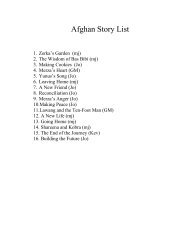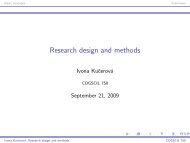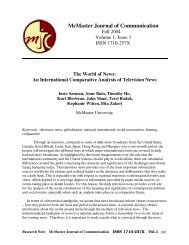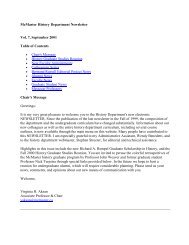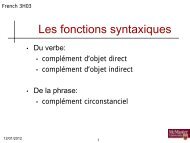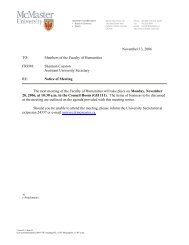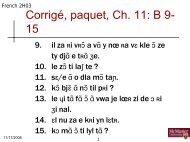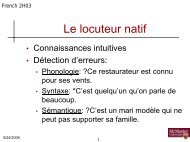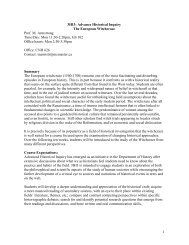The Syntax of Givenness Ivona Kucerová
The Syntax of Givenness Ivona Kucerová
The Syntax of Givenness Ivona Kucerová
You also want an ePaper? Increase the reach of your titles
YUMPU automatically turns print PDFs into web optimized ePapers that Google loves.
and contrastive foci readings. I will argue that even though G-movement is independently<br />
restricted by syntax like any other type <strong>of</strong> movement, it differs from other types <strong>of</strong> movement<br />
in that it is parasitic on head movement. <strong>The</strong> emergence <strong>of</strong> verb second will be seen<br />
as a consequence <strong>of</strong> this restriction. In section 1.4 I will explore further consequences <strong>of</strong><br />
this restriction, namely, differences in locality restrictions on G-movement dependent on<br />
head movement properties <strong>of</strong> the relevant head. In the last section <strong>of</strong> this chapter, 1.5, I<br />
will provide independent evidence for the proposed machinery. I will argue based on the<br />
distribution <strong>of</strong> pronouns that G-movement is a last resort operation. As such it takes place<br />
only if the relevant interpretation would not otherwise be available.<br />
1.1 G-movement<br />
<strong>The</strong> idea that word order in a language such as Czech is sensitive to the discourse in the<br />
sense that parts <strong>of</strong> a clause that are old (given, in the background etc.) linearly precede the<br />
elements that are new in the discourse has been investigated in Czech linguistics for a long<br />
time. 9<br />
<strong>The</strong> questions that have not, to my knowledge, been successfully addressed yet are (i)<br />
how exactly is the linear partition (i.e., given ≻ new) derived, and (ii) how is the word order<br />
within the old and the new part determined.<br />
Consider the example in (5). This sentence could be an answer to ‘What did Petr do<br />
yesterday with his car?’ <strong>The</strong> || sign corresponds to the partition between given and new.<br />
Now compare (5) and (6). <strong>The</strong> example in (6) shows the basic word order and as such it is<br />
a suitable answer to the question ‘What happened?’. 10 As we can see schematized in (7),<br />
the two word orders differ quite radically.<br />
(5) Petr auto včera || řídil rychle.<br />
Petr.Nom car.Acc yesterday drove fast<br />
‘Yesterday Petr drove his car fast.’<br />
←− S O Adv1 V Adv2<br />
9 <strong>The</strong> relevance <strong>of</strong> the discourse for word order has already been observed by traditional grammarians (for<br />
example, Gebauer 1900). In the pre-modern tradition, the observation was stated in terms <strong>of</strong> psychological<br />
and structural subjects. To my knowledge, the intuition about the broader relevance <strong>of</strong> the discourse was<br />
for the first time formalized in a more systematic way by Vilém Mathesius in Mathesius [1929] 1983 and<br />
Mathesius 1939 (the first version <strong>of</strong> the paper was presented in Prague in 1908). In order to describe the<br />
relation between word order and the discourse, Mathesius introduced the term aktuální členění. This term is<br />
usually translated as topic focus articulation. This is not an exact translation though. <strong>The</strong> literal translation<br />
would be something like structuring [<strong>of</strong> the sentence] dependent on the current context and referred to theme<br />
versus rheme distinction. Authors that further developed the notion <strong>of</strong> word order dependence on the current<br />
context include, for example, Daneš 1954, 1957, 1974; Novák 1959; ; Dokulil and Daneš 1958; Šmilauer<br />
1960; Adamec 1962; Firbas 1964; Hausenblas 1964; Sgall 1967; Benešová 1968; Hajičová 1973, 1974; Sgall<br />
et al. 1980, 1986; Hajičová et al. 1998, among many others. <strong>The</strong>re is no way I can acknowledge in this study<br />
all <strong>of</strong> the empirical observations, generalizations and linguistic insight that is present in the previous work on<br />
aktuální členění in Czech.<br />
10 I will provide diagnostics for determining basic word order in 1.2.<br />
12




